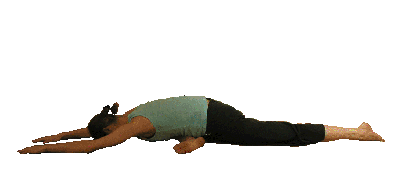
Benefits:
- A relaxing way to gently open the hips.
Contra-indications:
- If you have bad knees (especially any problems with the inner meniscus), watch the pressure there; if hips are too tight, that is where the pressure will be. If this happens, bring the front foot back, more towards or under that hip.
Alternatives & Options:
- To protect the front knee, keep foot flexed before coming forward;
- Keep the weight back into the hips as you come lower;
- Stay on the hands with arms straight, or come on to the elbows;
- Could lie on a bolster placed lengthwise under the chest;
- Students leaning to one side can place a support, like a folded blanket, under the bent knee’s hip to center themselves;
- To increase the effect of gravity, you could tuck the back toes under and lift the knee off the floor, pulling the heel backward;
- Really flexible students may try to bring front foot forward, pull bent knee more to the side and lay chest on top of shin;
- An alternative is Eye-of-the-Needle Pose.
Meridians & Organs Affected:
- Liver and Kidney lines because these lines come through the inner groin; the Stomach and Spleen meridians (from the line on the top of the back leg); the Gall Bladder line on outer leg.
Joints Affected :
- Hips make sure the knees are NOT complaining!
Hold for how long?
- Three to five minutes per side.
Counter poses?
- Reclining Windshield Wipers;
- Mild Spinal Lift or Supported Bridge pose.
Similar to?
- Sleeping Pigeon.
Other Notes:
- Nice to do between sides of Shoelace;
- Can combine with full Swan, which adds a backbend as well;
- Another option is to skip this pose and do Eye-of-the-Needle while lying on back. This reduces gravity’s effect and requires more upper body strength, but isn’t so deep;
- The full Swan creates a lot of tension in the hip joint: the Sleeping Swan has less. The student can find a tolerable compromise position somewhere between the two extremes by remaining on her elbows or hands. Lying straight down is not the deepest version of this pose, but it is the most relaxing for most students;
- Sometimes a subtle adjustment of the legs can increase the sensation in the front hip, and reduce the stretch in the quadriceps of the back leg.
